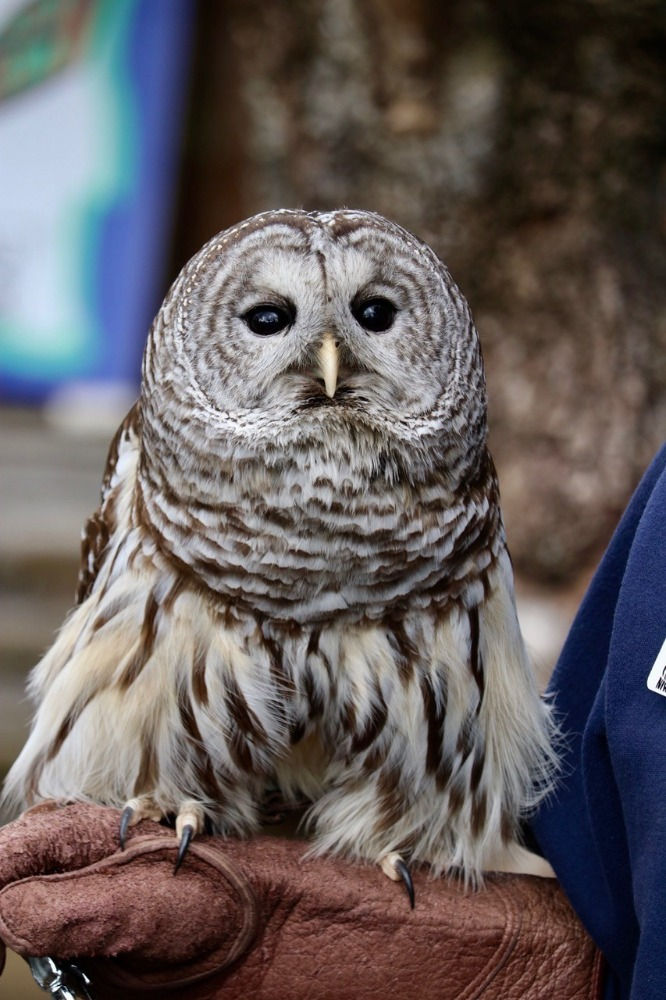All About Vancouver Island Owls
- Moira Rosser-Peterson

- Sep 25, 2023
- 4 min read
~wildlife education~
Owls inhabit all continents except Antarctica. They have adapted to a wide range of habitats from deserts, jungles, grasslands and forests, to the tundra of the high Arctic. There are over 250 species of owl in the world; there are 15 owl species in B.C. including the endangered Spotted Owl. We have seven species of owls resident at NIWRA (Great Horned, Great Grey, Barn, Barred, Western Screech, Long-eared and Snowy Owls).

Spook, one of our resident Great Horned Owls
All owls are raptors and catch live animals for their food. They will catch and eat just about any animal smaller than themselves; but most have a particular fondness for mice and rats. They will also eat smaller owls, other birds, snakes, voles, frogs, and even fish.
Owls have special features that make them great hunters. Their eyes, ears, beak, talons, and feathers are special adaptations to help them hunt.
Owls have very large eyes in relation to the size of their bodies. Their eyes gather and concentrate many times more light than ours do. Owls have forward-looking eyes, giving them binocular vision and excellent depth perception, which is an advantage in hunting. In fact, they can focus on both near and distant things at the same time, a special adaptation allowing them to properly gauge distance and avoid branches, etc., when they are pursuing prey.
Owls have an extra eyelid that moves back and forth over their eyes like a windshield wiper. This is called a nictitating membrane (a Greek word meaning to wink).
Instead of spherical, owl eyes are set deeply into their head. They cannot rotate or roll their eyes like we can, and in order to see around, they must turn their heads. Owls can turn their heads about 270 degrees. We can only look as far as our shoulders, or 180 degrees. Owls have extra neck vertebrae (14) to give them this mobility.

Elsa, our resident Snowy Owl.
All owls have extremely acute hearing. Some use their hearing more than sight for hunting, enabling them to hunt at night. Owl ears are offset top to bottom and back to front. This allows them to detect minute differences in sound direction to determine exactly where on the forest floor their prey might be, even if they can’t see it.
All owls have circles of feathers surrounding their eyes which act as facial disks. As owls don’t have earlobes to direct sound waves to their ears, these facial disks work like satellite dishes, focusing sound towards their ears.
Owls have a hooked beak, as do all raptors. This shape helps owls to kill their prey and tear the meat apart for swallowing. Owls’ mouths are large; in human terms, their mouths would extend all the way back to their ears. This allows them to swallow large pieces of food. Many are able to eat a fully-grown rat in one piece, generally headfirst.
Owls, like other raptors, have sharp talons used to catch their prey, to hold onto their dinner while they eat, and to defend themselves from enemies.
Owl feathers have colour patterns that act as protective camouflage, helping them to not be seen by their prey and their enemies. Owl feathers are like fine hairs, and some of them extend down over their feet. This allows them to fly silently. They are the ultimate stealth flyers. This means they have an advantage over many other birds whose more rigid feathers make a lot of noise when they are flying.

Oliver, one of our resident Barred Owls.
Injured owls are often found on or near roads, many of them hit by cars. The reason many owls hunt along roads and highways is the food waste we throw out of our cars; it attracts rodents who feed off the food wrappers, bread crusts, apple cores, etc. The rodents who feed on the roadside food waste attract owls and other raptors who prey on them and, unfortunately, they may be hit by passing vehicles, or fly into trees or fences when blinded by headlights. Please don't throw garbage out of your car; take it home and dispose of it responsibly, where it won’t harm our wildlife.
Some of our resident owls have been partially blinded or sustained broken wings from these collisions, and though we can often successfully treat broken bones, the soft tissue may not heal, and these owls would be unable to fly properly and feed themselves. Because of this, we are unable to release them, so we look after them for the rest of their lives.
The resident owls at NIWRA may live for more than 20 years -- longer than in the wild. They are well fed, have no enemies or stress, and have immediate veterinary care should they get sick or sustain an injury.
Two of our Barred Owls – Quinn and Oliver – are glove-trained and spend some of their time with their handlers, meeting visitors around NIWRA’s grounds. They are an essential part of our educational program.
You can help the wildlife in care at NIWRA by making a financial contribution on our secure website. Thank you so much for caring about wildlife!







Comments